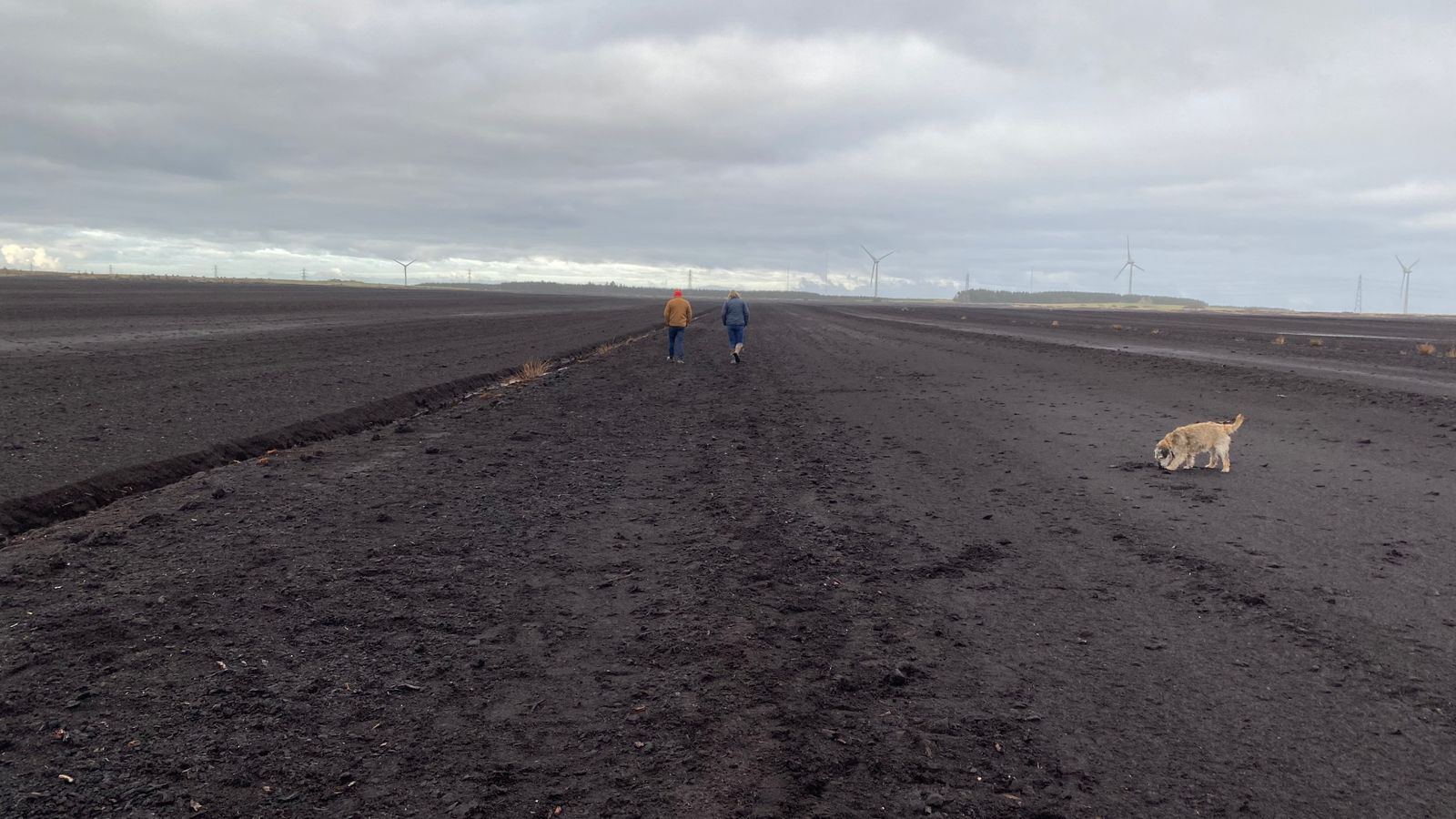Why peat is on the frontline of our battle against climate change
Degrading peat is estimated to be responsible for about 5% of UK carbon emissions, prompting debate over whether banning its use is the answer.
Tom Heap
Climate presenter @tomheapmedia
Saturday 4 March 2023 01:32, UK
The Climate Show24:01
Play Video – The Climate Show: Peat and whisky
The Climate Show: Peat and Whisky
Why you can trust Sky News
“You’ve heard of ‘tree-huggers’ protecting woodlands, We ‘bog-trotters’ love the wetlands.”
The words of agile ecologist Andrew McBride, from the Land and Habitats consultancy, as he strides across a marsh in Aberdeenshire.
With spectacular eyebrows and a gnarled wooden staff, notched along the shaft as a depth gauge, he looks every inch the swampland Gandalf. But he insists there’s no magic to restoring bogs: just add water.
Peat
“The point of the dam we are standing on is to hold more water here so the sphagnum moss can actually grow.
“Sphagnum is one of the main things that makes peat.”
But there is something almost magical about sphagnum moss. It looks like a bright green mass of feathery ferns.
It thrives without soil, has remarkable antiseptic properties, holds prodigious amounts of water and accumulates almost infinitely to make peat.
MORE ON CLIMATE CHANGE
An aerial shot of Tayvallich Estate in Argyll. Pic: Highlands Rewilding
Highlands Rewilding set to buy Tayvallich Estate in Argyll after £10m crowdfunding appeal
Pic: Thisis Rigged
William Wallace’s sword being checked for damage after casing smashed in climate protest at Wallace Monument in Stirling
Greta Thunberg was twice removed from the protests outside government buildings in Oslo, Norway. Pic: Alf Simensen/NTB/via Reuters
Greta Thunberg twice detained by police at anti-wind farm protest
Related Topics:
Climate Change
Peat covers about 12% of the UK and more than 20% of Scotland.
A marsh in Aberdeenshire.
It’s in the fields of the Fens, the moors of the Pennines and blanket bogs of the Highlands.
In places it can be at least five metres deep and across the country holds more carbon than the woodlands of the UK, France and Germany combined.
But once it’s drained and dried that carbon lock is broken and the greenhouse gas escapes.
Degrading peat is estimated to be responsible for about 5% of UK carbon emissions.
One of the contributors to that degradation is whisky. It is key to the process of making many brands often infused with the treasured “peaty reek”.
The Scottish government has announced a desire to “phase out the use of peat for the sake of the environment” and has not ruled out including whisky in that ban.
The multi-national drinks company Beam Suntory gave Sky News a tour of their Ardmore Distillery on the edge of Speyside.
The multi-national drinks company Beam Suntory gave Sky News a tour of their Ardmore Distillery on the edge of Speyside.
It’s a maze of giant vats, barrels and steampunk engineering accompanied by a magical mystery tour of aromas: malt, smoke, ancient wood and fresh fermentation.
The multi-national drinks company Beam Suntory gave Sky News a tour of their Ardmore Distillery on the edge of Speyside.
Alistair Longwell, their head of environment and distilling, points out that whisky is responsible for less than 1% of the peat extracted in the UK, but what they do use is vital.
“For our brands and many others, peat is fundamentally important.
“It creates that unique character and flavour that our consumers love.
“A ban (on its use) would have a unique and detrimental impact on what is our standard bearing export – so important not just to Scotland but the UK as a whole.”
His company is helping to fund the restoration of peat bogs close to the distillery under the watchful and appreciative eye of Andrew McBride.
“Government alone can’t do this so it’s very important that companies that use peat, and others that are using the natural environment, give something back.”
Click to subscribe to ClimateCast wherever you get your podcasts
But he also believes that wetlands have suffered from an image problem – seen as perilous, untrustworthy and linked with decay.
“Drain the Swamp” has even become a political chant.
“Bogs have been completely unloved for centuries, and they’ve been seen as sort of negative places,” he said.
“But when you actually start to understand them, you get onto them.
“You see the diversity, the different species.
“I think we’ve probably turned a corner now because people are paying much more attention to peatlands.”
Peat
The Scottish government certainly is.
Its proposals include phasing out the use of peat in gardening.
This is already scheduled to happen in England in 2024.
In reality, whisky’s iconic status and importance to the Scottish economy will probably save it from the ban.
Expect peat to vanish from the potting shed well before the drinks cabinet.
Related Topics
Climate Change






























